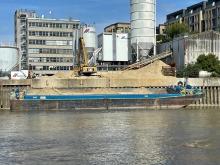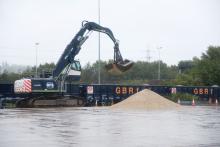Without efficient shipping and logistics, no aggregate materials supplier can hope to survive and prosper in the highly competitive modern marketplace. Guy Woodford reports.
Transporting aggregate and inert materials by rail offers many advantages over road haulage, including greatly reduced CO2 emissions, lower fuel costs, and faster and more reliable delivery times.
Having set in 2016 a new annual company record of 3 million tonnes of rail movements of aggregates and inert materials between its quarries and freight stations up and down Britain, in April 2017
The record 2016 haul also included the rail transport of 500,000 tonnes of inert materials to non-operational CEMEX UK quarries in the process of being restored to nature. The bulk of this inert material was transported from Willesden, North London freight station to CEMEX UK’s now closed Barrington quarry in Cambridgeshire.
CEMEX UK’s old quarry site restoration works was originally established to accommodate material from London’s CrossRail project and will also benefit from inert materials coming from the high profile HS2 rail megaproject, due to start later this year.
CEMEX UK’s temporary pop-up rail freight stations, including the one opened in Warrington, North West England in early 2016, continue to prove popular in meeting periods of high regional UK aggregates demand among construction customers. The Warrington freight station alone can handle 125,000tonnes/year and, due to its popularity, is likely to become a permanent aggregate collection point. CEMEX UK is looking at introducing a further two pop-up stations, another in North West England and one in South West England, before the end of 2017.
Meanwhile, the integration of new larger rail box wagons at Dove Holes quarry, which has been transporting aggregates by rail since 1863, has increased the site’s aggregate freight train capacity by 20% to 1700-2000tonnes [+10-15tonnes/wagon]. Similar box wagon upgrading is taking place at Barrington quarry.
Mark Grimshaw-Smith, head of rail freight at CEMEX UK, said: “We [CEMEX UK] transported 3 million tonnes of aggregate and inert materials by rail in 2016, up from 2.3 million tonnes in 2015. In 2017, we’d like to push on towards the 3.5million tonne milestone.
“We need to lobby as an industry to get the extra capacity out of
“We’re encouraged that Network Rail is running a Protect Our Freight Stations campaign, recognising their importance to the UK economy. We’ve also been using Network Rail’s Clothes Line analysis software, which can alert us to and provide images of pinch points which are causing delays on our rail freight routes. It means we are better equipped to work with our freight operators if they say a problem is more to do with Network Rail.”
As part of their efforts to increase capacity for aggregate rail freight on the UK rail network, Grimshaw-Smith said minerals extraction sector operators had come together to create a definition of an aggregate rail freight train as 450m long with a material carrying capacity of 2,000tonnes.
“I don’t think anybody’s yet run a 2,000 tonne box wagon train. It would be nice to be the first. With the new larger box wagons we have at Dove Holes, we’re looking to run a 2,000 tonne aggregate rail freight train from the quarry to Barking, East London freight station before the end of 2017. The Barking freight station is a key station for London and other South East England building contractor customers.”
Grimshaw-Smith said that around 40% of all materials that CEMEX UK excavates is used in-house to make concrete, asphalt and other products, helping protect to some extent the company from the volatility of external demand within the aggregates sector and run the train plan on a more consistent base.
He continued: “The materials supply challenge presented by projects like HS2, the Thames Tideway Tunnel and Moorside Power Station, all of which are anticipated to start within the next five years, should not be underestimated. And with the UK’s construction industry facing closer scrutiny than ever before, with issues of air quality and heavy congestion in urban areas dominating the headlines over recent months, there has never been a greater opportunity to come together to drive a shift towards more sustainable modes of transport.
“The publication of the Department for Transport’s ‘Rail Freight Strategy’ in September last year was a real step forward for the industry. It is heartening to see recognition of the scope for the rail industry to work more closely with the logistics sector to collaborate and explore new solutions to relieve the pressure on Britain’s road network.”
As one of the UK’s largest users of rail freight, moving around nine million tonnes of material across the country each year, Swan said rail freight is an industry that Tarmac believes in strongly. “We have a large number of rail-connected quarries and cement plants, across the country, and are committed to growing the volume of material transported by rail. Enhancing our rail freight network, not only builds on our current capability to meet customers’ requirements for high quality construction materials for national and local infrastructure, but also allows us to continue our drive towards more efficient, sustainable transport and a lower carbon built environment.
“Rail is only one part of the logistics mix however. It is vital that clients are able to work closely with supply chain partners to explore all appropriate options for a particular site to develop a comprehensive smart logistics programme from the outset. Urban or inner city sites, for example, may be able to utilise nearby railheads, using a range of HGVs to shuttle materials to site, rather than bringing them the full distance by road.
“Site access is another critical consideration, and clients and contractor teams need to ensure that site designs have been developed in tandem with materials delivery plans. Crucially, early engagement with materials providers and collaborative working should be prioritised to ensure operational solutions are considered from the initial stages of this project planning.”
Swan said there are already signs that large national infrastructure projects are beginning to embrace this more joined-up way of approaching their logistics challenges. Heathrow Airport’s recent announcement of plans to create four logistics hubs across the UK to help to maximise the efficiency of its off-site approach and reduce the impact of vehicle movements in West London is, believes Swan, a good example of a client understanding how a “well-considered approach to logistics can minimise disruption and help to win support for a project of scale with a number of societal factors to consider”.
He added: “For London-based projects, the River Thames also presents huge opportunities to help drive modal shift and encourage big infrastructure projects in the capital to consider a smarter approach to logistics. At Tarmac, we have recently invested in our operations along the river, and now operate a state-of-the-art barge loader from our Greenwich Wharf site to enable us to use a fleet of barges to deliver aggregates to construction and infrastructure projects.
“With congestion, vehicle emissions and air quality at a key issue in the capital, it is important that opportunities to use the River Thames as a strategic waterway to service customer projects are maximised. As an example, each return journey from Greenwich Wharf by barge removes 100 HGV transport movements from London’s roads and it is therefore vital that we continue to invest in and safeguard London’s wharf areas.”
With devolution to regional bodies an increasingly hot topic across the UK, Swan thinks it is essential that learnings from smart logistics programmes established to support major national infrastructure projects can be passed on to ongoing projects across the regions. “We need to come together as an industry to ensure that the future of infrastructure projects across the whole of the UK is smarter, more efficient and therefore more productive,” he concludes.
Gerard Cantwell, head of procurement and logistics at
Cantwell said AI’s logistics are nearly fully outsourced. “We have franchisees, major third party logistic companies and ad-hoc logistics partners. However, we’re in the process of moving into a regional logistics structure covering five regions: Scotland, the North, the Midlands, the South East, and the South West. In each of those regions we have a regional logistics manager working alongside a health and safety compliance manager and planning people. We’re also employing an overall head of road logistics to help drive forward our standards and maintain consistency in this area. We’re around about 80% there with the new structure. By end of Q2, beginning of Q3 we’ll be fully there.”
All the drivers in AI’s franchised fleets are working towards their bronze, silver and gold FORS [Fleet Operator Recognition Scheme] standards. Cantwell says that while the findings of customer surveys and questionnaires along with general feedback indicates that AI’s logistical arm delivers good customer service, the new regional set-up will encourage more consistent working practices, while also being more cost-effective and greener. “It will help us better utilise vehicles by minimising their empty running time. We also have high standards on health and safety and are keen to ensure continued compliance with health and safety regulations.”
AI’s drive to maintain high standards in its logistics delivery is also increasingly being aided by technology, as Cantwell notes:
“We utilise a lot of camera technology across our fleet to learn, train and, on occasion, to enforce. On each truck we’ve got forward, reverse and in-cab cameras. Some haulage drivers at times think it’s a bit like Big Brother watching over you, but it’s not. We don’t even look at the cameras apart from when there’s incidents. When we do, we find 95% of the time the camera footage proves that the driver was not at fault in an accident.
“Going forward, we’re looking at vehicle tracking technology along with IVMS (In-Vehicle Monitoring Systems) that analyse the efficiency of drivers, identifying and tackling issues such as harsh braking and accelerating. Vehicle tracking will be linked to our planning solutions for optimising our fleet network. All the work we’re doing on logistics is about trying to keep fresh and challenging ourselves and our haulier partners to improve.”
Cantwell said that he is part of a team working closely with AI’s logistic franchisees to identify the best long-term strategy for attracting and recruiting the right people to work as haulage drivers. “Our franchisee hauliers are our first port of call with the customer. Their perception of them is their perception of our business. I want to make sure going forward we’re dealing with franchisee hauliers and individuals that have the same work culture and objectives that we do as an organisation. It’s about looking at what support we’re giving our franchisees; what training are we giving them on things like vehicle documentation control and vehicle repair and maintenance; and what financial packages can we come up with that make it easier for our franchisees to run their business.
“Our business is very difficult from a logistics standpoint. There are so many variables and the level of change within a day is extremely high compared to many other businesses; things like weather could have an impact and delays on major roads due to accidents or infrastructure works. Sometimes as much as 40% of any daily plan will have to change due to outside influences. Our logistics performance, including our ability to cope with these outside influences, is of absolute critical importance to winning and retaining business.”
Hanson UK chief executive Daniel Cooper, said: “This significant investment is the first step in a strategic replacement programme for our existing fleet of eight dredgers which deliver marine aggregates into a network of wharves in both the UK and continental Europe. It is also a key part of our overall strategic plan. Marine-dredged sand and gravel is critical to our UK business. It is used in around half of our ready-mixed concrete plants and is becoming more and more important due to the increasing scarcity of land-won sand and gravel, particularly around London and South East England.”
The new trailing suction hopper dredgers, which will enter service in 2019, will be equivalent in size to Hanson’s existing A-Class vessels, carrying up to 5,500tonnes of sand and gravel.
The new ships, which will provide major improvements in fuel consumption, reliability and CO2 emissions, will be built by the Dutch shipbuilder Barkmeijer at its yard at Stroobos in the Netherlands.
Selecting the right partner took months of painstaking work by the Hanson project team, who visited shipyards in The Netherlands, Eastern Europe and China before making their final decision. After drawing up a detailed design and specification for the vessels, the team homed in on a shortlist of four whom they believed could deliver the project within a tight budget and timescale.
“We also had to be sure that our partner was capable of working to the highest quality standards and had a clear commitment to health and safety,” said Hanson procurement director Jas Suman. “Barkmeijer is a world leader in the shipbuilding industry and ticked all the boxes.”
The two-year build programme will be overseen by a dedicated project management team to ensure the design specification is followed and the timeline stays on track.









